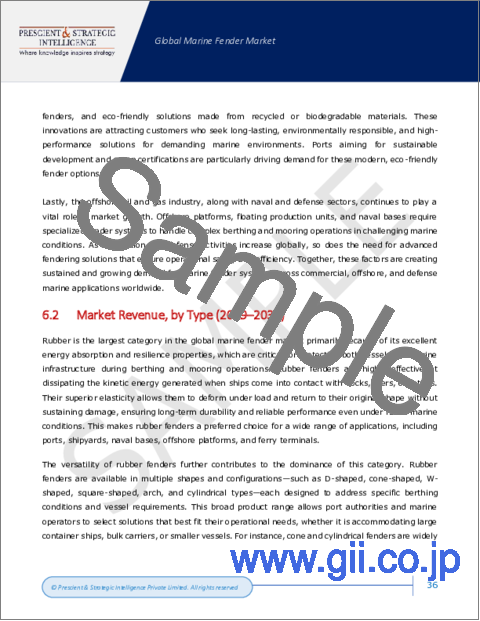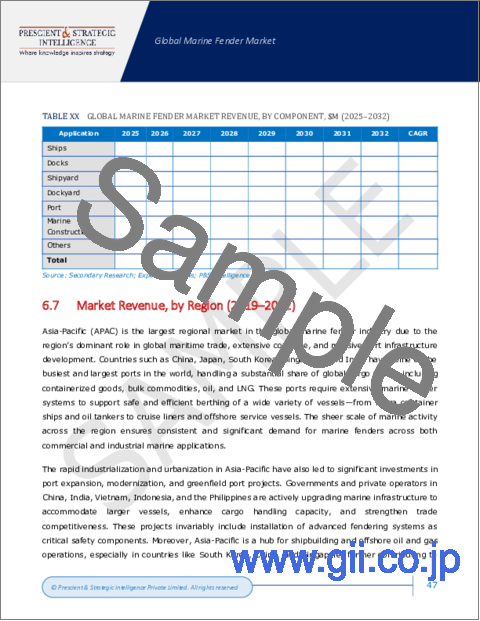|
|
市場調査レポート
商品コード
1460721
船舶用防舷材の世界市場:市場規模・シェア分析 - 動向、促進要因、競合情勢、将来予測 (2024年~2030年)Marine Fender Market Size & Share Analysis - Trends, Drivers, Competitive Landscape, and Forecasts (2024 - 2030) |
||||||
|
|||||||
| 船舶用防舷材の世界市場:市場規模・シェア分析 - 動向、促進要因、競合情勢、将来予測 (2024年~2030年) |
|
出版日: 2024年04月01日
発行: Prescient & Strategic Intelligence
ページ情報: 英文 280 Pages
納期: 2~3営業日
|
全表示
- 概要
- 目次
世界の船舶用防舷材市場は、2023年に7億4,350万米ドル、2030年には9億3,640万米ドルの規模に達し、3%以上のCAGRで成長する見通しです。
この成長の主な要因は、世界貿易量の増加です。国際海運部門は世界の物流の90%を担っており、これは現代生活と経済にとって重要であることを示しています。
国家間の貿易の増加、防衛費の増大、新しいターミナルや港湾の開発は、業界の拡大をさらに後押しすると考えられています。
市場分析
種類別では、2023年にゴムタイプが約30%のシェアで業界をリードしています。この成長の主な要因は、ドッキング時の損傷を軽減するため、柔軟で耐久性が高く、安価な素材への要求が高いことです。
発泡タイプは、今後数年間で3.8%と最も速いペースで進歩します。発泡タイプは、耐久性、低コスト、低メンテナンス、軽量、高電力吸収能力、高寿命、塩水中で採用された場合でも回復率が高いため、支持を集めています。
2023年の業界では、押出製造工程が約50%のシェアを占め、最大の貢献者でした。これは、大量生産が可能で、費用対効果が高く、汎用性があり、効率的な製造が可能なためです。
2023年の業界シェアは、個人所有が約75%でトップでした。これは、民間企業の意思決定の柔軟性と長期的な戦略重視のためです。
2023年には、取付構造部品が約55%のシェアで業界をリードしました。この成長の主な理由は、安全性、信頼できる性能、安定性などです。
用途別では、2023年にドック向けが約25%のシェアで業界最大の貢献者でした。船舶用防舷材は、衝撃力を吸収し、安全な港湾運営を保証し、船舶の損傷を回避するためにドックで広く採用されています。
地域別では、2023年にはアジア太平洋が約45%のシェアで業界をリードしました。同地域には世界最大の海運部門があります。
当レポートでは、世界の船舶用防舷材の市場について分析し、市場の基本構造・最新情勢や主な促進・抑制要因、世界全体および地域別・主要国の市場規模の動向見通し (金額ベース、2017~2030年)、種類別・製造工程別・所有者別・コンポーネント別・用途別の詳細動向、現在の市場競争の状況、主要企業のプロファイルなどを調査しております。
目次
第1章 調査範囲
第2章 調査手法
第3章 エグゼクティブサマリー
第4章 市場指標
第5章 業界の展望
- 市場力学
- 動向
- 促進要因
- 抑制要因/課題
- 促進要因/抑制要因の影響分析
- 新型コロナウイルス感染症 (COVID-19) の影響
- ポーターのファイブフォース分析
第6章 世界市場
- 概要
- 市場収益:種類別 (2017~2030年)
- ゴム市場の収益:種類別 (2017年~2030年)
- 市場収益:製造工程別 (2017~2030年)
- 市場収益:所有者別 (2017~2030年)
- 市場収益:コンポーネント別 (2017~2030年)
- 市場収益:用途別 (2017~2030年)
- 市場収益:地域別 (2017~2030年)
第7章 北米市場
- 概要
- 市場収益:種類別 (2017~2030年)
- ゴム市場の収益:種類別 (2017年~2030年)
- 市場収益:製造工程別 (2017~2030年)
- 市場収益:所有者別 (2017~2030年)
- 市場収益:コンポーネント別 (2017~2030年)
- 市場収益:用途別 (2017~2030年)
- 市場収益:国別 (2017~2030年)
第8章 欧州市場
第9章 アジア太平洋市場
第10章 ラテンアメリカ市場
第11章 中東・アフリカ (MEA) 市場
第12章 米国市場
- 概要
- 市場収益:種類別 (2017~2030年)
- ゴム市場の収益:種類別 (2017年~2030年)
- 市場収益:製造工程別 (2017~2030年)
- 市場収益:所有者別 (2017~2030年)
- 市場収益:コンポーネント別 (2017~2030年)
- 市場収益:用途別 (2017~2030年)
第13章 カナダ市場
第14章 ドイツ市場
第15章 フランス市場
第16章 英国市場
第17章 イタリア市場
第18章 スペイン市場
第19章 日本市場
第20章 中国市場
第21章 インド市場
第22章 オーストラリア市場
第23章 韓国市場
第24章 ブラジル市場
第25章 メキシコ市場
第26章 サウジアラビア市場
第27章 南アフリカ市場
第28章 アラブ首長国連邦 (UAE) 市場
第29章 競合情勢
- 市場参入企業とその提供製品/サービスの一覧
- 主要企業の競合ベンチマーク
- 主要企業の製品ベンチマーク
- 最近の戦略展開状況
第30章 企業プロファイル
- Trelleborg Marine and Infrastructure
- Sumitomo Rubber Industries Ltd.
- THE YOKOHAMA RUBBER CO. LTD.
- Qingdao Jier Engineering Rubber Co. Ltd.
- Bridgestone Corporation
- J.C. MacElroy Company Inc.
- Anchor Marine & Supply Inc.
- Marine Fenders International
- Jiangsu Ronggang Equipment Co. Ltd.
- Zhenjiang Tonly Rubber Co. Ltd.
- James Fisher and Sons plc.
第31章 付録
The marine fender market was USD 743.5 million in 2023, and it will touch USD 936.4 million, powering at more than 3% CAGR, by 2030.
The main factor for this growth is the rising volume of global trade. The international shipping sector is responsible for the carriage of 90% of the goods worldwide, which indicates its importance to modern life and economies.
The increasing trade between nations, the increasing defense expenses, and the development of new terminals and ports will further boost the industry expansion.
Marine fenders with flexible components are regularly employed to shield berthing structures. A key reason for the unscheduled interruption/downtime of berthing facilities is the failure of these structures. Companies in this market are focusing on improvements to make them more inexpensive and reduce the impact on the environment.
Metal-skinning absorbers, a backup system for conventional elastic fenders, are being employed to accomplish this purpose. Such absorbers reduce the danger of unscheduled downtimes due to elastic marine fenders' failure, thus, shielding the berthing structure.
The key factor behind this growth is the rising attention to sustainable aspects like component recycling & reuse, which have appeared as a cost-effective solution for manufacturers.
Market Analysis
The rubber type led the industry in 2023, with approximately 30% share. The major factor for this growth is the high requirement for flexible, highly durable, and inexpensive material to reduce the damage while docking.
The foam type will advance at the fastest rate, of 3.8%, in the years to come. Foam type is gaining traction because of its durability, low cost, low maintenance, low weight, high power absorption capacity, high life expectancy, and recovery rate, even when employed in saline water.
The extrusion manufacturing process was the largest contributor to the industry in 2023, with approximately 50% share. This is because of its capability to allow high-volume production, cost-effectiveness, versatility, and effective manufacturing.
Private ownership accounted for the leading share of the industry in 2023, of approximately 75%. This is because of the flexibility of private firms in decision-making and long-term strategic emphasis.
The mounting structure component led the industry in 2023, with approximately 55% share. The key reasons for this growth include security, reliable performance, and stability.
The dock application was the largest contributor to the industry in 2023, with approximately 25% share. Marine fenders are widely employed at the dock to absorb impact forces, guarantee safe port operations, and avoid damage to ships.
APAC led the industry in 2023, with approximately 45% share. The region is home to the largest shipping sector in the world.
APAC also has plenty of raw materials like rubber and a high production volume with innovative industrial technologies.
The marine fenders industry is quite competitive. Key players are focused on meeting the changing industry and customers' demands by employing strategic alliances and producing advanced products.
Cost, reliability, quality, and the capacity to serve an extensive range of marine structures are the major focus areas for players. They are also engaging in investment, geographical expansions, and collaborations to improve their presence.
Table of Contents
Chapter 1. Research Scope
- 1.1. Research Objectives
- 1.2. Market Definition
- 1.3. Analysis Period
- 1.4. Market Size Breakdown by Segments
- 1.4.1. Market size breakdown, by type
- 1.4.2. Market size breakdown, by manufacturing process
- 1.4.3. Market size breakdown, by ownership
- 1.4.4. Market size breakdown, by component
- 1.4.5. Market size breakdown, by application
- 1.4.6. Market size breakdown, by region
- 1.4.7. Market size breakdown, by country
- 1.5. Market Data Reporting Unit
- 1.5.1. Value
- 1.6. Key Stakeholders
Chapter 2. Research Methodology
- 2.1. Secondary Research
- 2.1.1. Paid
- 2.1.2. Unpaid
- 2.1.3. P&S Intelligence database
- 2.2. Primary Research
- 2.3. Market Size Estimation
- 2.4. Data Triangulation
- 2.5. Currency Conversion Rates
- 2.6. Assumptions for the Study
- 2.7. Notes and Caveats
Chapter 3. Executive Summary
Chapter 4. Market Indicators
Chapter 5. Industry Outlook
- 5.1. Market Dynamics
- 5.1.1. Trends
- 5.1.2. Drivers
- 5.1.3. Restraints/challenges
- 5.1.4. Impact analysis of drivers/restraints
- 5.2. Impact of COVID-19
- 5.3. Porter's Five Forces Analysis
- 5.3.1. Bargaining power of buyers
- 5.3.2. Bargaining power of suppliers
- 5.3.3. Threat of new entrants
- 5.3.4. Intensity of rivalry
- 5.3.5. Threat of substitutes
Chapter 6. Global Market
- 6.1. Overview
- 6.2. Market Revenue, by Type (2017-2030)
- 6.2.1. Rubber market revenue, by type (2017-2030)
- 6.3. Market Revenue, by Manufacturing Process (2017-2030)
- 6.4. Market Revenue, by Ownership (2017-2030)
- 6.5. Market Revenue, by Component (2017-2030)
- 6.6. Market Revenue, by Application (2017-2030)
- 6.7. Market Revenue, by Region (2017-2030)
Chapter 7. North America Market
- 7.1. Overview
- 7.2. Market Revenue, by Type (2017-2030)
- 7.2.1. Rubber market revenue, by type (2017-2030)
- 7.3. Market Revenue, by Manufacturing Process (2017-2030)
- 7.4. Market Revenue, by Ownership (2017-2030)
- 7.5. Market Revenue, by Component (2017-2030)
- 7.6. Market Revenue, by Application (2017-2030)
- 7.7. Market Revenue, by Country (2017-2030)
Chapter 8. Europe Market
- 8.1. Overview
- 8.2. Market Revenue, by Type (2017-2030)
- 8.2.1. Rubber market revenue, by type (2017-2030)
- 8.3. Market Revenue, by Manufacturing Process (2017-2030)
- 8.4. Market Revenue, by Ownership (2017-2030)
- 8.5. Market Revenue, by Component (2017-2030)
- 8.6. Market Revenue, by Application (2017-2030)
- 8.7. Market Revenue, by Country (2017-2030)
Chapter 9. APAC Market
- 9.1. Overview
- 9.2. Market Revenue, by Type (2017-2030)
- 9.2.1. Rubber market revenue, by type (2017-2030)
- 9.3. Market Revenue, by Manufacturing Process (2017-2030)
- 9.4. Market Revenue, by Ownership (2017-2030)
- 9.5. Market Revenue, by Component (2017-2030)
- 9.6. Market Revenue, by Application (2017-2030)
- 9.7. Market Revenue, by Country (2017-2030)
Chapter 10. LATAM Market
- 10.1. Overview
- 10.2. Market Revenue, by Type (2017-2030)
- 10.2.1. Rubber market revenue, by type (2017-2030)
- 10.3. Market Revenue, by Manufacturing Process (2017-2030)
- 10.4. Market Revenue, by Ownership (2017-2030)
- 10.5. Market Revenue, by Component (2017-2030)
- 10.6. Market Revenue, by Application (2017-2030)
- 10.7. Market Revenue, by Country (2017-2030)
Chapter 11. MEA Market
- 11.1. Overview
- 11.2. Market Revenue, by Type (2017-2030)
- 11.2.1. Rubber market revenue, by type (2017-2030)
- 11.3. Market Revenue, by Manufacturing Process (2017-2030)
- 11.4. Market Revenue, by Ownership (2017-2030)
- 11.5. Market Revenue, by Component (2017-2030)
- 11.6. Market Revenue, by Application (2017-2030)
- 11.7. Market Revenue, by Country (2017-2030)
Chapter 12. U.S. Market
- 12.1. Overview
- 12.2. Market Revenue, by Type (2017-2030)
- 12.2.1. Rubber market revenue, by type (2017-2030)
- 12.3. Market Revenue, by Manufacturing Process (2017-2030)
- 12.4. Market Revenue, by Ownership (2017-2030)
- 12.5. Market Revenue, by Component (2017-2030)
- 12.6. Market Revenue, by Application (2017-2030)
Chapter 13. Canada Market
- 13.1. Overview
- 13.2. Market Revenue, by Type (2017-2030)
- 13.2.1. Rubber market revenue, by type (2017-2030)
- 13.3. Market Revenue, by Manufacturing Process (2017-2030)
- 13.4. Market Revenue, by Ownership (2017-2030)
- 13.5. Market Revenue, by Component (2017-2030)
- 13.6. Market Revenue, by Application (2017-2030)
Chapter 14. Germany Market
- 14.1. Overview
- 14.2. Market Revenue, by Type (2017-2030)
- 14.2.1. Rubber market revenue, by type (2017-2030)
- 14.3. Market Revenue, by Manufacturing Process (2017-2030)
- 14.4. Market Revenue, by Ownership (2017-2030)
- 14.5. Market Revenue, by Component (2017-2030)
- 14.6. Market Revenue, by Application (2017-2030)
Chapter 15. France Market
- 15.1. Overview
- 15.2. Market Revenue, by Type (2017-2030)
- 15.2.1. Rubber market revenue, by type (2017-2030)
- 15.3. Market Revenue, by Manufacturing Process (2017-2030)
- 15.4. Market Revenue, by Ownership (2017-2030)
- 15.5. Market Revenue, by Component (2017-2030)
- 15.6. Market Revenue, by Application (2017-2030)
Chapter 16. U.K. Market
- 16.1. Overview
- 16.2. Market Revenue, by Type (2017-2030)
- 16.2.1. Rubber market revenue, by type (2017-2030)
- 16.3. Market Revenue, by Manufacturing Process (2017-2030)
- 16.4. Market Revenue, by Ownership (2017-2030)
- 16.5. Market Revenue, by Component (2017-2030)
- 16.6. Market Revenue, by Application (2017-2030)
Chapter 17. Italy Market
- 17.1. Overview
- 17.2. Market Revenue, by Type (2017-2030)
- 17.2.1. Rubber market revenue, by type (2017-2030)
- 17.3. Market Revenue, by Manufacturing Process (2017-2030)
- 17.4. Market Revenue, by Ownership (2017-2030)
- 17.5. Market Revenue, by Component (2017-2030)
- 17.6. Market Revenue, by Application (2017-2030)
Chapter 18. Spain Market
- 18.1. Overview
- 18.2. Market Revenue, by Type (2017-2030)
- 18.2.1. Rubber market revenue, by type (2017-2030)
- 18.3. Market Revenue, by Manufacturing Process (2017-2030)
- 18.4. Market Revenue, by Ownership (2017-2030)
- 18.5. Market Revenue, by Component (2017-2030)
- 18.6. Market Revenue, by Application (2017-2030)
Chapter 19. Japan Market
- 19.1. Overview
- 19.2. Market Revenue, by Type (2017-2030)
- 19.2.1. Rubber market revenue, by type (2017-2030)
- 19.3. Market Revenue, by Manufacturing Process (2017-2030)
- 19.4. Market Revenue, by Ownership (2017-2030)
- 19.5. Market Revenue, by Component (2017-2030)
- 19.6. Market Revenue, by Application (2017-2030)
Chapter 20. China Market
- 20.1. Overview
- 20.2. Market Revenue, by Type (2017-2030)
- 20.2.1. Rubber market revenue, by type (2017-2030)
- 20.3. Market Revenue, by Manufacturing Process (2017-2030)
- 20.4. Market Revenue, by Ownership (2017-2030)
- 20.5. Market Revenue, by Component (2017-2030)
- 20.6. Market Revenue, by Application (2017-2030)
Chapter 21. India Market
- 21.1. Overview
- 21.2. Market Revenue, by Type (2017-2030)
- 21.2.1. Rubber market revenue, by type (2017-2030)
- 21.3. Market Revenue, by Manufacturing Process (2017-2030)
- 21.4. Market Revenue, by Ownership (2017-2030)
- 21.5. Market Revenue, by Component (2017-2030)
- 21.6. Market Revenue, by Application (2017-2030)
Chapter 22. Australia Market
- 22.1. Overview
- 22.2. Market Revenue, by Type (2017-2030)
- 22.2.1. Rubber market revenue, by type (2017-2030)
- 22.3. Market Revenue, by Manufacturing Process (2017-2030)
- 22.4. Market Revenue, by Ownership (2017-2030)
- 22.5. Market Revenue, by Component (2017-2030)
- 22.6. Market Revenue, by Application (2017-2030)
Chapter 23. South Korea Market
- 23.1. Overview
- 23.2. Market Revenue, by Type (2017-2030)
- 23.2.1. Rubber market revenue, by type (2017-2030)
- 23.3. Market Revenue, by Manufacturing Process (2017-2030)
- 23.4. Market Revenue, by Ownership (2017-2030)
- 23.5. Market Revenue, by Component (2017-2030)
- 23.6. Market Revenue, by Application (2017-2030)
Chapter 24. Brazil Market
- 24.1. Overview
- 24.2. Market Revenue, by Type (2017-2030)
- 24.2.1. Rubber market revenue, by type (2017-2030)
- 24.3. Market Revenue, by Manufacturing Process (2017-2030)
- 24.4. Market Revenue, by Ownership (2017-2030)
- 24.5. Market Revenue, by Component (2017-2030)
- 24.6. Market Revenue, by Application (2017-2030)
Chapter 25. Mexico Market
- 25.1. Overview
- 25.2. Market Revenue, by Type (2017-2030)
- 25.2.1. Rubber market revenue, by type (2017-2030)
- 25.3. Market Revenue, by Manufacturing Process (2017-2030)
- 25.4. Market Revenue, by Ownership (2017-2030)
- 25.5. Market Revenue, by Component (2017-2030)
- 25.6. Market Revenue, by Application (2017-2030)
Chapter 26. Saudi Arabia Market
- 26.1. Overview
- 26.2. Market Revenue, by Type (2017-2030)
- 26.2.1. Rubber market revenue, by type (2017-2030)
- 26.3. Market Revenue, by Manufacturing Process (2017-2030)
- 26.4. Market Revenue, by Ownership (2017-2030)
- 26.5. Market Revenue, by Component (2017-2030)
- 26.6. Market Revenue, by Application (2017-2030)
Chapter 27. South Africa Market
- 27.1. Overview
- 27.2. Market Revenue, by Type (2017-2030)
- 27.2.1. Rubber market revenue, by type (2017-2030)
- 27.3. Market Revenue, by Manufacturing Process (2017-2030)
- 27.4. Market Revenue, by Ownership (2017-2030)
- 27.5. Market Revenue, by Component (2017-2030)
- 27.6. Market Revenue, by Application (2017-2030)
Chapter 28. U.A.E. Market
- 28.1. Overview
- 28.2. Market Revenue, by Type (2017-2030)
- 28.2.1. Rubber market revenue, by type (2017-2030)
- 28.3. Market Revenue, by Manufacturing Process (2017-2030)
- 28.4. Market Revenue, by Ownership (2017-2030)
- 28.5. Market Revenue, by Component (2017-2030)
- 28.6. Market Revenue, by Application (2017-2030)
Chapter 29. Competitive Landscape
- 29.1. List of Market Players and their Offerings
- 29.2. Competitive Benchmarking of Key Players
- 29.3. Product Benchmarking of Key Players
- 29.4. Recent Strategic Developments
Chapter 30. Company Profiles
- 30.1. Trelleborg Marine and Infrastructure
- 30.1.1. Business overview
- 30.1.2. Product and service offerings
- 30.1.3. Key financial summary
- 30.2. Sumitomo Rubber Industries Ltd.
- 30.2.1. Business overview
- 30.2.2. Product and service offerings
- 30.2.3. Key financial summary
- 30.3. THE YOKOHAMA RUBBER CO. LTD.
- 30.3.1. Business overview
- 30.3.2. Product and service offerings
- 30.3.3. Key financial summary
- 30.4. Qingdao Jier Engineering Rubber Co. Ltd.
- 30.4.1. Business overview
- 30.4.2. Product and service offerings
- 30.4.3. Key financial summary
- 30.5. Bridgestone Corporation
- 30.5.1. Business overview
- 30.5.2. Product and service offerings
- 30.5.3. Key financial summary
- 30.6. J.C. MacElroy Company Inc.
- 30.6.1. Business overview
- 30.6.2. Product and service offerings
- 30.6.3. Key financial summary
- 30.7. Anchor Marine & Supply Inc.
- 30.7.1. Business overview
- 30.7.2. Product and service offerings
- 30.7.3. Key financial summary
- 30.8. Marine Fenders International
- 30.8.1. Business overview
- 30.8.2. Product and service offerings
- 30.8.3. Key financial summary
- 30.9. Jiangsu Ronggang Equipment Co. Ltd.
- 30.9.1. Business overview
- 30.9.2. Product and service offerings
- 30.9.3. Key financial summary
- 30.10. Zhenjiang Tonly Rubber Co. Ltd.
- 30.10.1. Business overview
- 30.10.2. Product and service offerings
- 30.10.3. Key financial summary
- 30.11. James Fisher and Sons plc.
- 30.11.1. Business overview
- 30.11.2. Product and service offerings
- 30.11.3. Key financial summary
Chapter 31. Appendix
- 31.1. Abbreviations
- 31.2. Sources and References
- 31.3. Related Reports





